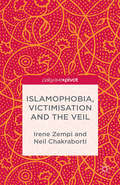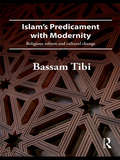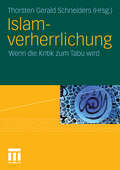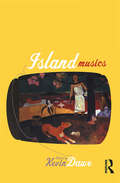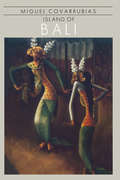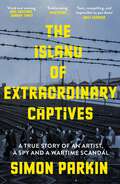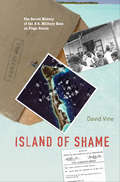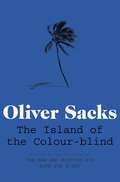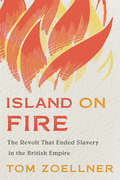- Table View
- List View
Islamophobia, Victimisation and the Veil (Palgrave Hate Studies)
by I. Zempi N. ChakrabortiThis book examines the experiences of veiled Muslim women as victims of Islamophobia, and the impact of this victimisation upon women, their families and wider Muslim communities. It proposes a more effective approach to engaging with these victims; one which recognises their multiple vulnerabilities and their distinct cultural and religious needs.
Islamophobic Hate Crime: A Student Textbook
by Imran Awan Irene ZempiIn recent years, there has been a sharp increase in anti-Muslim attacks. What is driving the proliferation of these hate crimes? Why are Muslims being demonised? Building on current research and drawing upon real-life examples and case studies, this book provides an accessible introduction to Islamophobia and Islamophobic hate crimes along with the various responses to this form of victimisation. Chapters cover a range of topics including: • Definitions of hate crime and Islamophobia • Islamophobic hate crime online • Gender and Islamophobia • Media representations of Islamophobia • Institutional Islamophobia As one of the first student resources dedicated to the subject of Islamophobia, this book will be instructive and important reading for those engaged in a range of topics in criminology, including hate crime, victimology and victimisation, crime and media, and gender and crime.
Islamophobic Hate Crime: A Student Textbook
by Imran Awan Irene ZempiIn recent years, there has been a sharp increase in anti-Muslim attacks. What is driving the proliferation of these hate crimes? Why are Muslims being demonised? Building on current research and drawing upon real-life examples and case studies, this book provides an accessible introduction to Islamophobia and Islamophobic hate crimes along with the various responses to this form of victimisation. Chapters cover a range of topics including: • Definitions of hate crime and Islamophobia • Islamophobic hate crime online • Gender and Islamophobia • Media representations of Islamophobia • Institutional Islamophobia As one of the first student resources dedicated to the subject of Islamophobia, this book will be instructive and important reading for those engaged in a range of topics in criminology, including hate crime, victimology and victimisation, crime and media, and gender and crime.
Islam's Predicament with Modernity: Religious Reform and Cultural Change
by Bassam TibiIslam's Predicament with Modernity presents an in-depth cultural and political analysis of the issue of political Islam as a potential source of tensions and conflict, and how this might be peacefully resolved. Looking at the issue of modernity from an Islamic point of view, the author examines the role of culture and religion in Muslim society under conditions of globalisation, and analyses issues such as law, knowledge and human rights. He engages a number of significant studies on political Islam and draws on detailed case studies, rejecting the approaches of both Orientalists and apologists and calling instead for a genuine Islamic pluralism that accepts the equality of others. Situating modernity as a Western product at the crux of his argument, he argues that a separation of religion and politics is required, which presents a challenge to the Islamic worldview. This critical analysis of value conflicts, tensions and change in the Islamic world will be of interest to scholars and advanced students of international relations, social theory, political science, religion, Islamic studies and Middle Eastern studies.
Islam's Predicament with Modernity: Religious Reform and Cultural Change
by Bassam TibiIslam's Predicament with Modernity presents an in-depth cultural and political analysis of the issue of political Islam as a potential source of tensions and conflict, and how this might be peacefully resolved. Looking at the issue of modernity from an Islamic point of view, the author examines the role of culture and religion in Muslim society under conditions of globalisation, and analyses issues such as law, knowledge and human rights. He engages a number of significant studies on political Islam and draws on detailed case studies, rejecting the approaches of both Orientalists and apologists and calling instead for a genuine Islamic pluralism that accepts the equality of others. Situating modernity as a Western product at the crux of his argument, he argues that a separation of religion and politics is required, which presents a challenge to the Islamic worldview. This critical analysis of value conflicts, tensions and change in the Islamic world will be of interest to scholars and advanced students of international relations, social theory, political science, religion, Islamic studies and Middle Eastern studies.
Islamverherrlichung: Wenn die Kritik zum Tabu wird
by Thorsten Gerald SchneidersMuss sich unter Muslimen in Deutschland etwas ändern? Viele dürften die Frage mit „Ja“ beantworten. Offenbar gibt es genügend Anlass zu „Islamkritik“. Leider missbrauchen dies viele als Vehikel für pure Ressentiments. Doch das darf nicht dazu führen, jede Form von Kritik in den Wind zu schlagen und das Bild vom gelebten Islam schön zu färben. Beide Haltungen sind problematisch und daher Inhalt eines umfassenden zweibändigen Buchprojekts. Während der bereits erschienene Band „Islamfeindlichkeit“ unterschiedliche Aspekte des europäischen Islamhasses vergangener Jahrhunderte bis zur heutigen Hetze im Internet dokumentiert, zeigt das vorliegende Buch „Islamverherrlichung“, wie vernünftige Islamkritik ohne Pauschalisierung, Populismus und Polemik aussehen kann. Ausgewiesene Experten sprechen dazu offen theologische Herausforderungen an und weisen auf Missstände in der muslimischen Gesellschaft Deutschlands hin. Es geht sowohl um brisante Einzelthemen wie Jihad, Antisemitismus oder Kopftuch, als auch um grundlegende Fragen zum Koran, zum Propheten Muhammad oder zur Scharia. Zudem finden sich Auseinandersetzungen mit bekannten Einzelpersonen und Islamverbänden. Mit Beiträgen von Nasr Hamid Abu Zayd, Lamya Kaddor, Ömer Özsoy, Rabeya Müller, Adel Theodor Khoury, Udo Tworuschka, Katajun Amirpur, Hartmut Bobzin und anderen.
Island and Empire: How Civil War in Crete Mobilized the Ottoman World (Stanford Ottoman World Series: Critical Studies in Empire, Nature, and Knowledge)
by Uğur Z. PeçeIn the 1890s, conflict erupted on the Ottoman island of Crete. At the heart of the Crete Question, as it came to be known around the world, were clashing claims of sovereignty between Greece and the Ottoman Empire. The island was of tremendous geostrategic value, boasting one of the deepest natural harbors in the Mediterranean, and the conflict quickly gained international dimensions with an unprecedented collective military intervention by six European powers. Island and Empire shows how events in Crete ultimately transformed the Middle East. Uğur Zekeriya Peçe narrates a connected history of international intervention, mass displacement, and popular mobilization. The conflict drove a wedge between the island's Muslims and Christians, quickly acquiring a character of civil war. Civil war in turn unleashed a humanitarian catastrophe with the displacement of more than seventy thousand Muslims from Crete. In years following, many of those refugees took to the streets across the Ottoman world, driving the largest organized modern protest the empire had ever seen. Exploring both the emergence and legacies of violence, Island and Empire demonstrates how Cretan refugees became the engine of protest across the empire from Salonica to Libya, sending ripples farther afield beyond imperial borders. This history that begins within an island becomes a story about the end of an empire.
Island and Empire: How Civil War in Crete Mobilized the Ottoman World (Stanford Ottoman World Series: Critical Studies in Empire, Nature, and Knowledge)
by Uğur Z. PeçeIn the 1890s, conflict erupted on the Ottoman island of Crete. At the heart of the Crete Question, as it came to be known around the world, were clashing claims of sovereignty between Greece and the Ottoman Empire. The island was of tremendous geostrategic value, boasting one of the deepest natural harbors in the Mediterranean, and the conflict quickly gained international dimensions with an unprecedented collective military intervention by six European powers. Island and Empire shows how events in Crete ultimately transformed the Middle East. Uğur Zekeriya Peçe narrates a connected history of international intervention, mass displacement, and popular mobilization. The conflict drove a wedge between the island's Muslims and Christians, quickly acquiring a character of civil war. Civil war in turn unleashed a humanitarian catastrophe with the displacement of more than seventy thousand Muslims from Crete. In years following, many of those refugees took to the streets across the Ottoman world, driving the largest organized modern protest the empire had ever seen. Exploring both the emergence and legacies of violence, Island and Empire demonstrates how Cretan refugees became the engine of protest across the empire from Salonica to Libya, sending ripples farther afield beyond imperial borders. This history that begins within an island becomes a story about the end of an empire.
Island Criminology (New Horizons in Criminology)
by John Scott Zoe StainesTen percent of the world’s population lives on islands, but until now the place and space characteristics of islands in criminological theory have not been deeply considered. This book moves beyond the question of whether islands have more, or less, crime than other places, and instead addresses issues of how, and by whom, crime is defined in island settings, which crimes are policed and visible, and who is subject to regulation. These questions are informed by ‘the politics of place and belonging’ and the distinctive social networks and normative structures of island communities.
Island Criminology (New Horizons in Criminology)
by John Scott Zoe StainesTen percent of the world’s population lives on islands, but until now the place and space characteristics of islands in criminological theory have not been deeply considered. This book moves beyond the question of whether islands have more, or less, crime than other places, and instead addresses issues of how, and by whom, crime is defined in island settings, which crimes are policed and visible, and who is subject to regulation. These questions are informed by ‘the politics of place and belonging’ and the distinctive social networks and normative structures of island communities.
Island Ecosystems: Challenges to Sustainability (Social and Ecological Interactions in the Galapagos Islands)
by Stephen J. Walsh Carlos F. Mena Jill R. Stewart Juan Pablo Muñoz PérezSustainable development is a process to improve the quality of life of people, while maintaining the ability of social–ecological systems to continue to provide valuable ecological services that social systems require. In the Galapagos Islands, the maintenance of amenity resources to support tourism and the quality of life of residents is explicitly linked to ecosystem goods and services, particularly, the accessibility to high-quality natural environments and the terrestrial and marine visitation sites that showcase iconic species.On June 26-30, 2022, the Galapagos Science Center celebrated its 10-Year Anniversary. As the crowning event of the anniversary celebration, the World Summit on Island Sustainability was held on San Cristobal Island, Galapagos Archipelago of Ecuador. The intent of the World Summit was to bring together leading experts on island ecosystems and, particularly, on island sustainability from across the globe to represent a diversity of perspectives, approaches, and stakeholder groups. The World Summit was an exclusive event that featured an “expert convening” of scholars and practitioners to address the social, terrestrial, and marine sub-systems of the Galapagos Islands and other similarly challenged island ecosystems from around the globe. The World Summit attracted 150 scientists to the Galapagos Islands to discuss projects conducted, for instance, in the Galapagos Islands, Hawaii, Guam, French Polynesia, Chile, Australia, and the Caribbean Islands. Island vulnerability, resilience, and sustainability were examined by scholars, for instance, from the University of North Carolina at Chapel Hill, Universidad San Francisco de Quito, Catholic University of Chile, University of Guam, James Cook University, University of the Sunshine Coast, North Carolina State University, North Carolina Museum of Natural Sciences, California Academy of Sciences, University of San Francisco, and the University of South Alabama as well as affiliated scientists from Exeter University, University of Edinburgh, University of Southampton, and the Galapagos National Park. The World Summit also included scholars from Re:wild, World Wildlife Fund, EarthEcho, and the East-West Center, Hawaii.
Island Geographies: Essays and conversations (Routledge Studies in Human Geography)
by Elaine StratfordIslands and their environs – aerial, terrestrial, aquatic – may be understood as intensifiers, their particular and distinctive geographies enabling concentrated study of many kinds of challenges and opportunities. This edited collection brings together several emerging and established academics with expertise in island studies, as well as interest in geopolitics, governance, adaptive capacity, justice, equity, self-determination, environmental care and protection, and land management. Individually and together, their perspectives provide theoretically useful, empirically grounded evidence of the contributions human geographers can make to knowledge and understanding of island places and the place of islands. Nine chapters engage with the themes, issues, and ideas that characterise the borderlands between island studies and human geography and allied fields, and are contributed by authors for whom matters of place, space, environment, and scale are key, and for whom islands hold an abiding fascination. The penultimate chapter is rather more experimental – a conversation among these authors and the editor – while the last chapter offers timely reflections upon island geographies’ past and future, penned by the first named professor of island geography, Stephen Royle.
Island Geographies: Essays and conversations (Routledge Studies in Human Geography)
by Elaine StratfordIslands and their environs – aerial, terrestrial, aquatic – may be understood as intensifiers, their particular and distinctive geographies enabling concentrated study of many kinds of challenges and opportunities. This edited collection brings together several emerging and established academics with expertise in island studies, as well as interest in geopolitics, governance, adaptive capacity, justice, equity, self-determination, environmental care and protection, and land management. Individually and together, their perspectives provide theoretically useful, empirically grounded evidence of the contributions human geographers can make to knowledge and understanding of island places and the place of islands. Nine chapters engage with the themes, issues, and ideas that characterise the borderlands between island studies and human geography and allied fields, and are contributed by authors for whom matters of place, space, environment, and scale are key, and for whom islands hold an abiding fascination. The penultimate chapter is rather more experimental – a conversation among these authors and the editor – while the last chapter offers timely reflections upon island geographies’ past and future, penned by the first named professor of island geography, Stephen Royle.
Island Historical Ecology: Socionatural Landscapes of the Eastern and Southern Caribbean
In the first book-length treatise on historical ecology of the West Indies, Island Historical Ecology addresses Caribbean island ecologies from the perspective of social and cultural interventions over approximately eight millennia of human occupations. Environmental coring carried out in carefully selected wetlands allowed for the reconstruction of pre-colonial and colonial landscapes on islands between Venezuela and Puerto Rico. Comparisons with well-documented patterns in the Mediterranean and Pacific islands place this case study into a larger context of island historical ecology.
Island in the City: A Post-war Childhood in a Community Defined by its Boundaries (Wordcatcher History)
by Ray NoyesA working-class district of Cardiff, the area where the author lived as a child was experienced as an island in the 1940s and 50s; a world surrounded by the noise and clamour of industry. Docks, railways, canals, foundries, gasworks, steam engines and ships all called siren-like to children eager to explore the world outside it. Cowboys fought Indians; heroes fought dragons and inventors made cars out of planks of wood and pram wheels. School continued to have many echoes of the Victorian era and the school on the island, in particular, even looked like one. Its soaring ceilings, stone archways and hard plank desks were the same as when it was first built in the 1880s. Discipline was still achieved with the use of the cane. Duty and good citizenship were inherently part of the values of such establishments. Exploration and inventiveness ensured the summer holidays were ones of excitement and occasionally danger. The clanking of engines and the flames of industry were a constant background to a childhood full of wonder, yet one that was still grounded in echoes of Edwardian values. How these mutated as society changed under the pressure of inventions and innovations provide a fascinating insight into a changing Britain. In a couple of decades, the country moved from being powered by horses and steam, to nuclear power and oil. Homes that knew only coal and gas were transformed by electricity as were the new inventions within them. Television arrived, as did the transistor and eventually the microchip. Gradually, the foundries, docks, railways and canals closed. Gone was the noise and the constant glow of industry. The island became transformed, but becoming less exciting than it once was. This is a gentle, anecdotal walk through two decades of a changing world seen through the eyes of a child.
Island In Trust: Culture Change And Dependence In A Micronesian Economy
by James G. PeoplesThis book is a case study of economic change on a small Pacific island. The island, called Kosrae by the inhabitants, lies in the eastern Caroline Islands, which are part of the geographic and culture area known popularly as Micronesia. The author’s major aim is to show how economic change in one of the island's four villages is affected by the recent policies of the United States government, which has administered the widely scattered islands of Micronesia since 1947.
Island In Trust: Culture Change And Dependence In A Micronesian Economy
by James G. PeoplesThis book is a case study of economic change on a small Pacific island. The island, called Kosrae by the inhabitants, lies in the eastern Caroline Islands, which are part of the geographic and culture area known popularly as Micronesia. The author’s major aim is to show how economic change in one of the island's four villages is affected by the recent policies of the United States government, which has administered the widely scattered islands of Micronesia since 1947.
Island Musics
by Kevin DaweWhat does the music of Madagascar or Trinidad tell us about the islands themselves and their inhabitants? Is there something unique about island musics? How does island music differ from its mainland counterparts? Drawing on a range of diverse examples from around the globe, this book examines the culture of island music and offers insight into local identities. Case studies look at how music, tradition, popular culture and islander life are linked in modern maritime societies. The islands covered include Crete, Ibiza, Zanzibar, Trinidad, Cuba, Madagascar and Papua New Guinea. In revealing the current practice behind modern island musics, the book considers the role of world music, exotica, global tourism, novels and travel writing in constructing fanciful images of islanders and island life. Island Musics throws into question some of our most basic notions and assumptions about island societies. There are a number of problems common to all island societies that vary in significance depending on an islands size, demographics and its proximity to the mainland. Problems include remoteness and insularity, peripherality to centralized sites of decision-making, a limited range of natural resources, specialization of economics, small markets, a narrow skills base, poor infrastructure and environmental fragility. These issues are discussed in relation to the creation of music in the construction of an islander identity. Of particular interest is the way in which islanders discuss their music and how it articulates the idea of the other and diaspora. Finally, Island Musics considers the musical industry, music education and the preservation of musical cultural heritage.
Island Musics: Performance And Ethnography In A Mediterranean Island Society
by Kevin DaweWhat does the music of Madagascar or Trinidad tell us about the islands themselves and their inhabitants? Is there something unique about island musics? How does island music differ from its mainland counterparts? Drawing on a range of diverse examples from around the globe, this book examines the culture of island music and offers insight into local identities. Case studies look at how music, tradition, popular culture and islander life are linked in modern maritime societies. The islands covered include Crete, Ibiza, Zanzibar, Trinidad, Cuba, Madagascar and Papua New Guinea. In revealing the current practice behind modern island musics, the book considers the role of world music, exotica, global tourism, novels and travel writing in constructing fanciful images of islanders and island life. Island Musics throws into question some of our most basic notions and assumptions about island societies. There are a number of problems common to all island societies that vary in significance depending on an islands size, demographics and its proximity to the mainland. Problems include remoteness and insularity, peripherality to centralized sites of decision-making, a limited range of natural resources, specialization of economics, small markets, a narrow skills base, poor infrastructure and environmental fragility. These issues are discussed in relation to the creation of music in the construction of an islander identity. Of particular interest is the way in which islanders discuss their music and how it articulates the idea of the other and diaspora. Finally, Island Musics considers the musical industry, music education and the preservation of musical cultural heritage.
Island Of Bali
by Miguel CovarrubiasFirst published in 1937, Island of Bali is still regarded by many as the most authoritative text on Bali and its fascinating people. Included is a wealth of information on the daily life, art, customs and religion of this magical Island of the Gods. In the author's own words it presents a bird's-eye view of Balinese life and culture. Miguel Covarrubias, the author, was a noted painter and caricaturist as well as a student of anthropology. He lived in Bali for a total of three years in the early 1930s, and today his account is as fresh and insightful as it was when it was originally published. Introducing the island with a survey of hits history, geography and social structure, Covarrubias goes on to present a captivating picture of Balinese art, music and drama. Religion, witchcraft, death and cremation are also covered. Island of Bali will appeal to anyone with interest in this unique island, from general Eat, Pray, Love readers to serious anthropologist alike. Complementing the text are 90 drawings by Covarrubias and countless others by Balinese artists. Also included are 114 half-tone photographs, and five full-color paintings by the author.
Island Of Bali
by Miguel CovarrubiasFirst published in 1937, Island of Bali is still regarded by many as the most authoritative text on Bali and its fascinating people. Included is a wealth of information on the daily life, art, customs and religion of this magical Island of the Gods. In the author's own words it presents a bird's-eye view of Balinese life and culture. Miguel Covarrubias, the author, was a noted painter and caricaturist as well as a student of anthropology. He lived in Bali for a total of three years in the early 1930s, and today his account is as fresh and insightful as it was when it was originally published. Introducing the island with a survey of hits history, geography and social structure, Covarrubias goes on to present a captivating picture of Balinese art, music and drama. Religion, witchcraft, death and cremation are also covered. Island of Bali will appeal to anyone with interest in this unique island, from general Eat, Pray, Love readers to serious anthropologist alike. Complementing the text are 90 drawings by Covarrubias and countless others by Balinese artists. Also included are 114 half-tone photographs, and five full-color paintings by the author.
The Island of Extraordinary Captives: A True Story of an Artist, a Spy and a Wartime Scandal
by Simon ParkinThe police came for Peter Fleischmann in the early hours. It reminded the teenager of the Gestapo's moonlit roundups he had narrowly avoided at home in Berlin. Now, having endured a perilous journey to reach England - hiding from the rampaging Nazi thugs at his orphanage, boarding a Kindertransport to safety - here the aspiring artist was, on a ship bound for the Isle of Man, suspected of being a Nazi spy. What had gone wrong?In May 1940, faced with a country gripped by paranoia, Prime Minister Winston Churchill ordered the internment of all German and Austrian citizens living in Britain. Most, like Peter, were refugees who had come to the country to escape Nazi oppression. They were now imprisoned by the very country in which they had staked their trust. Painstakingly researched from dozens of unpublished first-hand accounts and previously classified documents, The Island of Extraordinary Captives tells, for the first time, the story of history's most astonishing internment camp and of how a group of world-renown artists, musicians and academics came to be seen as 'enemy aliens'. The Island of Extraordinary Captives is the story of a battle between fear and compassion at a time of national crisis. It reveals how Britain's treatment of refugees during the Second World War led to one of the nation's most shameful missteps, and how hope and creativity can flourish in even the most challenging circumstances.
Island of Shame: The Secret History of the U.S. Military Base on Diego Garcia
by David VineThe American military base on the island of Diego Garcia is one of the most strategically important and secretive U.S. military installations outside the United States. Located near the remote center of the Indian Ocean and accessible only by military transport, the little-known base has been instrumental in American military operations from the Cold War to the war on terror and may house a top-secret CIA prison where terror suspects are interrogated and tortured. But Diego Garcia harbors another dirty secret, one that has been kept from most of the world--until now. Island of Shame is the first major book to reveal the shocking truth of how the United States conspired with Britain to forcibly expel Diego Garcia's indigenous people--the Chagossians--and deport them to slums in Mauritius and the Seychelles, where most live in dire poverty to this day. Drawing on interviews with Washington insiders, military strategists, and exiled islanders, as well as hundreds of declassified documents, David Vine exposes the secret history of Diego Garcia. He chronicles the Chagossians' dramatic, unfolding story as they struggle to survive in exile and fight to return to their homeland. Tracing U.S. foreign policy from the Cold War to the war on terror, Vine shows how the United States has forged a new and pervasive kind of empire that is quietly dominating the planet with hundreds of overseas military bases. Island of Shame is an unforgettable exposé of the human costs of empire and a must-read for anyone concerned about U.S. foreign policy and its consequences. The author will donate all royalties from the sale of this book to the Chagossians.
The Island of the Colour-blind
by Oliver Sacks'Sacks is rightly renowned for his empathy . . . anyone with a taste for the exotic will find this beautifully written book highly engaging' Sunday Times Always fascinated by islands, Oliver Sacks is drawn to the Pacific by reports of the tiny atoll of Pingelap, with its isolated community of islanders born totally colour-blind; and to Guam, where he investigates a puzzling paralysis endemic there for a century. Along the way, he re-encounters the beautiful, primitive island cycad trees - and these become the starting point for a meditation on time and evolution, disease and adaptation, and islands both real and metaphorical in The Island of the Colour-Blind.
Island on Fire: The Revolt That Ended Slavery in the British Empire
by Tom ZoellnerFrom a New York Times bestselling author, a gripping account of the slave rebellion that led to the abolition of slavery in the British Empire. For five horrific weeks after Christmas in 1831, Jamaica was convulsed by an uprising of its enslaved people. What started as a peaceful labor strike quickly turned into a full-blown revolt, leaving hundreds of plantation houses in smoking ruins. By the time British troops had put down the rebels, more than a thousand Jamaicans lay dead from summary executions and extrajudicial murder. While the rebels lost their military gamble, their sacrifice accelerated the larger struggle for freedom in the British Atlantic. The daring and suffering of the Jamaicans galvanized public opinion throughout the empire, triggering a decisive turn against slavery. For centuries bondage had fed Britain’s appetite for sugar. Within two years of the Christmas rebellion, slavery was formally abolished. Island on Fire is a dramatic day-by-day account of this transformative uprising. A skillful storyteller, Tom Zoellner goes back to the primary sources to tell the intimate story of the men and women who rose up and tasted liberty for a few brief weeks. He provides the first full portrait of the rebellion's enigmatic leader, Samuel Sharpe, and gives us a poignant glimpse of the struggles and dreams of the many Jamaicans who died for liberty.
